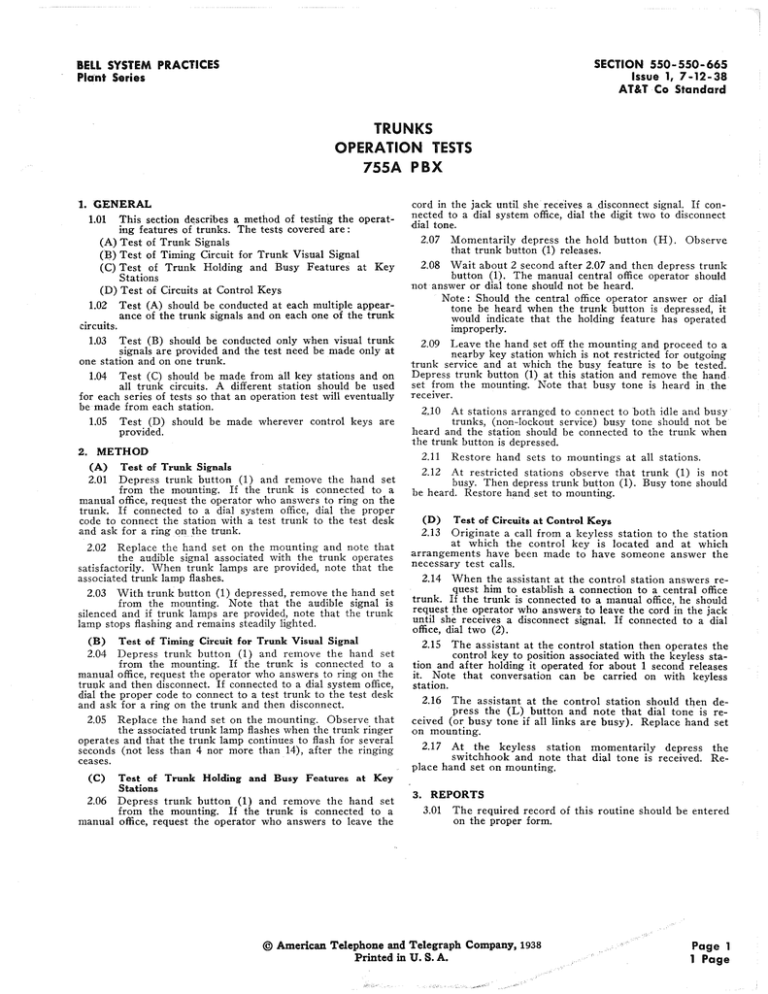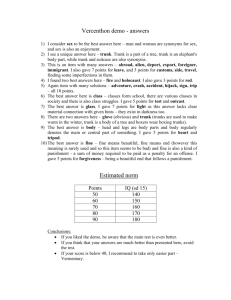TRUNKS OPERATION TESTS
advertisement

SECTION 550-550-665 Issue 1, 7-12-38 AT&T Co Standard BELL SYSTEM PRACTICES Plant Series TRUNKS OPERATION TESTS 755A PBX 1. GENERAL 1.01 This section describes a method of testing the operating features of trunks. The tests covered are: (A) Test of Trunk Signals (B) Test of Timing Circuit for Trunk Visual Signal (C) Test of Trunk Holding and Busy Features at Key Stations (D) Test of Circuits at Control Keys 1.02 Test (A) should be conducted at each multiple appearance of the trunk signals and on each one of the trunk circuits. 1.03 Test (B) should be conducted only when visual trunk signals are provided and the test need be made only at one station and on one trunk. 1.04 Test (C) should be made from all key stations and on all trunk circuits. A different station should be used for each series of tests so that an operation test will eventually be made from each station. 1.05 Test (D) should be made wherever control keys are provided. 2. METHOD (A) 2.01 Test of Trunk Signals Depress trunk button (1) and remove the hand set from the mounting. If the trunk is connected to a manual office, request the operator who answers to ring on the trunk. If connected to a dial system office, dial the proper code to connect the station with a test trunk to the test desk and ask for a ring on the trunk. 2.02 Replace the hand set on the mounting and note that the audible signal associated with the trunk operates satisfactorily. When trunk lamps are provided, note that the associated trunk lamp flashes. 2.03 With trunk button (1) depressed, remove the hand set from the mounting. Note that the audible signal is silenced and if trunk lamps are provided, note that the trunk lamp stops flashing and remains steadily lighted. (B) Test of Timing Circuit for Trunk Visual Signal Depress trunk button (1) and remove the hand set from the mounting. If the trunk is connected to a manual office, request the operator who answers to ring on the trunk and then disconnect. If connected to a dial system office, dial the proper code to connect to a test trunk to the test desk and ask for a ring on the trunk and then disconnect. 2.05 Replace the hand set on the mounting. Observe that the associated trunk lamp flashes when the trunk ringer operates and that the trunk lamp continues to flash for several seconds (not less than 4 nor more than 14), after the ringing ceases. 2.04 (C) 2.06 Test of Trunk Holding and Busy Features at Key Stations Depress trunk button (1) and remove the hand set from the mounting. If the trunk is connected to a manual office, request the operator who answers to leave the cord in the jack until she receives a ,disconnect signal. If connected to a dial system office, dial the digit two to disconnect dial tone. 2.07 Momentarily depress the hold button (H). Observe that trunk button (1) releases. 2.08 Wait about 2 second after 2.07 and then depress trunk button (1). The manual central office operator should 110t answer or dial tone should not be heard. Note: Should the central office operator answer or dial tone be heard when the trunk button is depressed, it would indicate that the holding feature has operated improperly. 2.09 Leave the hand set off the mounting and proceed to a nearby key station which is not restricted for outgoing trunk service and at which the busy feature is to be tested. Depress trunk button (1) at this station and remove the hand set from the mounting. Note that busy tone is heard in the receiver. 2.10 At stations arranged to connect to both idle and busy trunks, (non-lockout service) busy tone should not be heard and the station should be connected to the trunk when the trunk button is depressed. 2.11 Restore hand sets to mountings at all stations. 2.12 At restricted stations observe that trunk (1) is not busy. Then depress trunk button (1). Busy tone should be heard. Restore handset to mounting. (D) Test of Circuits at Control Keys Originate a call from a keyless station to the station at which the control key is located and at which arrangements have been made to have someone answer the necessary test calls. 2.13 2.14 When the assistant at the control station answers request him to establish a connection to a central office trunk. If the trunk is connected to a manual office, he should request the operator who answers to leave the cord in the jack until she receives a disconnect signal. If connected to a dial office, dial two (2). 2.15 The assistant at the control station then operates the control key to position associated with the keyless station and after holding it operated for about 1 second releases it. Note that conversation can be carried on with keyless station. 2.16 The assistant at the control station should then depress the (L) button and note that dial tone' is received (or busy tone if all links are busy). Replace hand set on mounting. 2.17 At the keyless station momentarily depress the switchhook and note that dial tone is received. Replace hand set on mounting. 3. REPORTS 3.01 The required record of this routine should be entered on the proper form. © American Telephone and Telegraph Company, 1938 Printed in U. S. A. Page 1 1 Page





